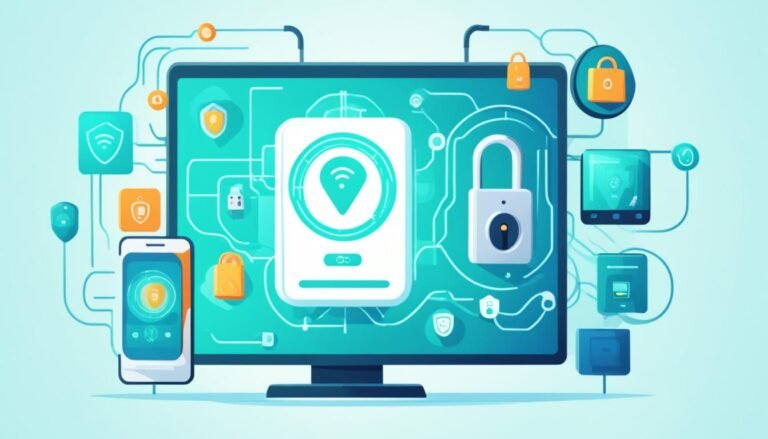Internet of Things (IoT) Applications in Finance
Did you know that the Internet of Things (IoT) is rapidly transforming the finance industry? From contactless payments to fraud detection and automation of core finance processes, IoT is revolutionizing how financial institutions operate and serve their customers.
With IoT, everyday objects are connected to the internet, allowing them to collect and share data in real-time. This technology is driving innovation and opening up new opportunities in the finance sector. Smart technology in banking, IoT devices in financial services, and IoT solutions for financial institutions are just some of the ways that IoT is reshaping the financial landscape.
Key Takeaways:
- IoT is revolutionizing the finance industry, enabling faster decision-making and improved efficiency.
- IoT devices in finance automate core processes, enhance customer experiences, and detect fraud.
- Implementing IoT in finance requires careful considerations for data management and cybersecurity.
- IoT in finance has the potential to drive digital transformation and create a more connected financial landscape.
- Privacy concerns and security challenges must be addressed for the responsible use of IoT in finance.
What is IoT in Finance?
The Internet of Things (IoT) in finance refers to the use of IoT technology and devices to collect and exchange data in real-time. This technology allows for the automation of tasks, analysis of data for decision-making, and improvement of processes in the finance industry.
IoT devices in finance can include mobile point-of-sale systems, wearables for tracking employee productivity, and sensors for monitoring asset condition and performance. By leveraging IoT technology, financial institutions can collect and share data easily, automate processes, and improve customer experiences.
The use of IoT devices in finance enables faster, data-driven decision-making, leading to improved operational efficiency and streamlined financial processes. These devices also play a significant role in fraud detection and cybersecurity, as they help detect anomalies and potential threats.
The benefits of implementing IoT in finance extend beyond operational improvements. IoT technology paves the way for innovative financial services and products, enabling personalized offerings and enhanced customer experiences. By connecting various devices and leveraging real-time data insights, financial institutions can provide tailored solutions and better anticipate customer needs.
Examples of IoT devices in finance:
1. Mobile point-of-sale systems: These devices enable secure and contactless payments, improving the overall customer experience during transactions.
2. Wearables for employee productivity tracking: By using wearables equipped with IoT technology, financial institutions can monitor employee productivity in real-time, identify areas for improvement, and optimize resource allocation.
3. Asset monitoring sensors: IoT sensors can track the condition and performance of assets such as ATMs or infrastructure, enabling proactive maintenance, reducing downtime, and enhancing efficiency.
“IoT devices in finance play a crucial role in automating processes, improving operational efficiency, and enhancing customer experiences.”
The use of IoT technology in finance holds immense potential for the industry’s future. As financial institutions continue to embrace IoT devices and solutions, they will unlock new opportunities for innovation, efficiency, and customer-centric services.
Benefits of Using IoT in Finance
The use of IoT in finance offers several benefits. By leveraging IoT technology, financial institutions can harness the power of connected devices and collect data from multiple sources, enabling faster and more informed decision-making processes. This real-time data analysis empowers organizations to stay ahead of market trends and make data-driven business decisions.
One of the key advantages of IoT in financial services is its ability to support machine-to-machine communication and automate critical tasks. This streamlines finance and accounting operations, reducing manual effort and increasing efficiency. By automating repetitive processes, finance professionals can focus on strategic initiatives, such as analyzing financial data and providing valuable insights.
Tracking employee and business performance in real-time is another valuable aspect of IoT in finance. Through the use of IoT devices, organizations can monitor key performance indicators and identify areas for improvement. This real-time tracking ensures efficient operations and allows for timely interventions to optimize productivity.
Furthermore, IoT technology enables personalized customer experiences in the finance industry. By leveraging data collected from IoT devices, financial institutions can gain insights into customer preferences and behaviors. This data-driven approach allows for targeted marketing efforts, tailored product recommendations, and personalized customer interactions, ultimately enhancing customer satisfaction and loyalty.
Fraud detection and improved regulatory compliance are additional benefits offered by IoT in finance. IoT devices can help detect anomalies and irregularities in financial transactions, enabling early fraud detection and prevention. By analyzing vast amounts of data in real-time, financial institutions can identify suspicious patterns and take action promptly. Compliance with regulations and industry standards is also facilitated through IoT technology, as it enables organizations to monitor and report data accurately and efficiently.
Realizing the Benefits of IoT in Finance
To demonstrate the benefits of using IoT in finance, let’s consider a hypothetical scenario involving a retail bank. Through the deployment of IoT devices, such as self-service kiosks and smart ATMs, the bank can collect customer data and usage patterns. This data can be analyzed to optimize the placement and functionality of these devices, making banking services more accessible and convenient for customers. Additionally, by implementing IoT-enabled fraud detection systems, the bank can proactively identify and prevent fraudulent activities, safeguarding customer assets and maintaining trust.
Overall, the benefits of using IoT in finance extend far beyond what has been discussed here. This technology has the potential to revolutionize the financial industry, providing efficiency, accuracy, and enhanced customer satisfaction. Embracing IoT in finance positions organizations at the forefront of digital transformation, enabling them to adapt to evolving customer expectations and stay ahead of the competition.
“The use of IoT in finance offers efficiency, accuracy, and enhanced customer satisfaction.”
| Benefits of Using IoT in Finance |
|---|
| Faster and more informed decision-making |
| Streamlined finance and accounting operations |
| Real-time tracking of employee and business performance |
| Personalized customer experiences |
| Fraud detection and prevention |
| Improved regulatory compliance |
Use Cases of IoT in Finance
IoT technology has revolutionized the finance industry, bringing forth a wide range of use cases that drive innovation and efficiency. Here are some of the notable applications of IoT in finance:
- IoT Payments: IoT facilitates contactless transactions through devices like smartphones and smartwatches, revolutionizing the way we make payments.
- Enhanced Customer Service: With IoT devices, financial institutions can provide prompt assistance and personalized experiences to their customers, fostering long-term relationships.
- Risk Management and Personalized Insurance: IoT sensors collect real-time data on insured assets, enabling better risk assessment and the customization of insurance policies to meet individual needs.
- Real-time Auditing: IoT technology enables transaction tracking in real-time, streamlining the auditing process and ensuring transparency and accuracy.
- Fraud Detection: IoT devices play a crucial role in detecting and preventing fraudulent activities, safeguarding financial institutions and their customers.
- ATM Management: IoT is used to monitor the status and performance of ATMs, ensuring efficient operations and optimal customer experiences.
- Wealth Management: IoT devices provide real-time insights into investment portfolios, enabling wealth managers to make informed decisions and optimize returns for their clients.
- Supply Chain Finance: IoT enhances supply chain management in the finance industry by providing real-time visibility into inventory levels, improving efficiency and reducing costs.
- Personalized Banking Services: IoT enables financial institutions to offer personalized banking services tailored to individual preferences and needs, enhancing customer satisfaction.
The use cases of IoT in finance are expanding rapidly, transforming the industry and redefining the way financial services are delivered and experienced.
Implementing IoT in Finance
Implementing IoT in the finance industry requires careful planning and considerations to ensure successful integration. To effectively implement IoT, it is crucial to identify proven use cases within finance functions where IoT is commonly used. By leveraging existing successful implementations, financial institutions can gain valuable insights and guidance in their own IoT implementation process.
One of the key areas to focus on is strengthening data management structures. With the vast amount of data generated by IoT devices, having robust data management systems in place is essential. This includes establishing efficient data collection, storage, and analysis processes to derive actionable insights and facilitate informed decision-making. Additionally, implementing adequate cybersecurity measures is crucial to protect sensitive financial data from potential cyber threats and breaches.
Tracking return on investment (ROI) is another important aspect of implementing IoT in finance. It is essential to evaluate the impact of IoT investments and measure the effectiveness of the implemented solutions. This helps financial institutions assess the value and efficiency of their IoT initiatives and make data-driven decisions for future investments.
To overcome the challenges associated with IoT implementation in finance, learning from successful implementations in the industry is invaluable. By studying and understanding the approaches taken by other financial institutions, organizations can gain valuable insights into best practices, potential pitfalls, and effective strategies to mitigate challenges.
Overall, successful implementation of IoT in finance is dependent on proper planning, robust data management structures, strong security measures, and a clear understanding of ROI. By carefully considering these factors and learning from successful implementations, financial institutions can harness the full potential of IoT technology to drive innovation, enhance efficiency, and deliver improved experiences to their customers.
IoT and the Future of Finance
The future of finance is on the brink of transformation with the continuous development and implementation of IoT technology. As IoT devices and solutions become increasingly advanced and widely adopted, they have the potential to revolutionize the way financial services are delivered and consumed. IoT technology opens up a world of possibilities, enabling more seamless and personalized experiences for customers, improving operational efficiency, enhancing risk management, and driving innovation in financial products and services.
With IoT, financial institutions can harness the power of real-time data to make faster and more informed decisions. Connected devices enable data-driven insights that empower financial professionals to adapt to changing market conditions and customer needs swiftly. This translates into better risk assessment, optimized investment strategies, and superior portfolio management.
Furthermore, IoT technology has the potential to drive customer-centricity to new heights. Through personalized data collection and analysis, financial institutions can tailor services and offerings to meet individual customers’ unique needs. From personalized banking experiences to customized advice and recommendations, IoT enables financial institutions to create more meaningful and relevant connections with their customers.
In addition to its impact on customer experiences and operational efficiency, IoT plays a crucial role in improving risk management in the financial industry. IoT devices can provide real-time monitoring and tracking of assets, enabling proactive risk mitigation and predictive maintenance. By leveraging IoT technology, financial institutions can enhance their ability to detect and prevent fraud, identify patterns of suspicious behavior, and ensure compliance with regulatory requirements.
Another compelling aspect of IoT in finance is its potential to drive financial inclusion. With IoT-enabled devices, financial services can be extended to underserved populations, opening up access to banking services, insurance, and investments. This can significantly contribute to reducing socioeconomic disparities and fostering economic growth in marginalized communities.
However, while the future of finance is undoubtedly IoT-driven, it is essential to address the challenges of security and privacy. As the number of connected devices increases, so does the vulnerability to cyber threats. Financial institutions must prioritize robust security measures, employing encryption, authentication protocols, and network monitoring to safeguard against unauthorized access and data breaches. Additionally, strict adherence to privacy regulations and responsible data management practices is crucial to ensure the trust and confidence of customers.
With the right strategies for security and privacy, IoT-powered fintech solutions have the potential to transform not only the financial industry but also the lives of individuals and communities. IoT is set to redefine finance, creating a more connected, efficient, and inclusive financial landscape that empowers both businesses and consumers alike.
Challenges and Considerations for IoT in Finance
While IoT offers significant benefits in finance, it also presents challenges and considerations that require careful attention. These challenges can impact the security, privacy, and data management aspects of IoT implementation in the financial services industry.
Security of IoT Devices and Networks
One major challenge is ensuring the security of IoT devices and networks in finance. As these devices are connected to the internet, they can be vulnerable to cyber attacks. Financial institutions must implement robust security measures, including encryption, authentication protocols, and regular software updates, to protect against unauthorized access and data breaches.
Privacy Concerns with IoT in Banking
The collection and use of personal data through IoT devices raise privacy concerns in banking. Financial institutions must ensure that customer data is collected, stored, and shared securely and in compliance with data protection regulations. Clear privacy policies, informed consent, and data anonymization techniques can help address these concerns and maintain customer trust.
Data Management
The sheer volume of data generated by IoT devices in finance poses a significant data management challenge. Financial institutions must have strong data management capabilities to handle and analyze this data effectively. This includes implementing scalable infrastructure, employing advanced analytics tools, and ensuring data governance practices to derive meaningful insights and make data-driven decisions.
To address these challenges, financial institutions should prioritize security measures, implement privacy policies, and invest in data management capabilities. These considerations are crucial for the successful and responsible use of IoT in finance, ensuring trust, compliance, and the protection of customer data.
Impact of IoT on the Financial Services Industry
The rapid adoption of Internet of Things (IoT) technology has had a profound impact on the financial services industry. IoT has revolutionized the way financial services are delivered, driving digital transformation and reshaping traditional banking processes. By connecting devices and leveraging real-time data, IoT has ushered in a new era of connected and automated financial services.
One of the key transformations brought about by IoT is the enhancement of operational efficiency within financial institutions. Through IoT implementation, banks and other financial service providers can streamline their operations and reduce costs. For example, IoT sensors can monitor equipment performance and proactively alert maintenance teams, reducing downtime and optimizing performance. This results in significant cost savings and improved efficiency across the organization.
The impact of IoT is not limited to operational improvements alone. IoT has also greatly improved customer experiences in the financial services industry. By leveraging IoT devices and data analytics, financial institutions are able to offer personalized services and tailored product recommendations. For instance, banks can use IoT data to analyze customer behavior and offer customized financial advice or product suggestions based on their specific needs and preferences. This level of personalization enhances customer satisfaction and loyalty.
Furthermore, IoT has facilitated data-driven decision-making in the financial services industry. With the vast amount of real-time data generated by IoT devices, financial institutions are able to make informed and proactive decisions. For example, IoT sensors can collect data on customer behavior, market trends, and risk factors, enabling banks to identify potential opportunities and mitigate risks in a timely manner.
Overall, IoT has sparked a revolution in the financial services industry, disrupting traditional banking processes and paving the way for innovation. By harnessing the power of IoT, financial institutions can provide more efficient services, improve customer experiences, and drive strategic decision-making. The IoT transformation in finance is reshaping the industry, leading to a more connected, data-driven, and customer-centric future.
Conclusion
The Internet of Things (IoT) has revolutionized the finance industry, bringing about various benefits and driving innovation. The use of IoT devices and solutions has significantly improved decision-making processes, streamlined operations, enhanced customer experiences, and improved risk management. However, the implementation of IoT in the finance industry requires careful attention to data management, security, and privacy considerations.
While IoT offers immense opportunities, it also presents challenges that need to be addressed. Cybersecurity threats and privacy concerns must be effectively managed to ensure the responsible use of IoT in finance. Financial institutions must implement strong security measures and comply with relevant regulations to safeguard customer data and maintain trust.
In conclusion, IoT technology has a profound impact on the future of finance, shaping a more connected, efficient, and inclusive financial landscape. By embracing IoT and addressing its challenges, the finance industry can unlock the full potential of this innovative technology, ultimately transforming the way financial services are delivered and consumed.








